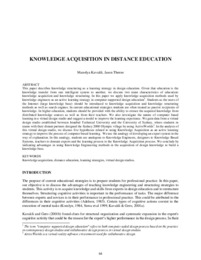| dc.contributor.author | Kavakli, Manolya | en |
| dc.contributor.author | Thorne, Jason | en |
| dc.coverage.spatial | CY - Λευκωσία | en |
| dc.creator | Kavakli, Manolya | en |
| dc.creator | Thorne, Jason | en |
| dc.date.accessioned | 2016-02-25T08:22:14Z | |
| dc.date.available | 2016-02-25T08:22:14Z | |
| dc.date.issued | 2003 | |
| dc.identifier.uri | http://hdl.handle.net/10797/14784 | en |
| dc.description | Περιέχει το πλήρες κείμενο | el |
| dc.description.abstract | This paper describes knowledge structuring as a learning strategy in design education. Given that education is the knowledge transfer from one intelligent system to another, we discuss two main characteristics of education: knowledge acquisition and knowledge structuring. In this paper we apply knowledge acquisition methods used by knowledge engineers as an active learning strategy in computer supported design education1. Students as the users of the Internet (large knowledge base) should be introduced to knowledge acquisition and knowledge structuring methods as well as search engines. In current educational strategies students are often treated as passive recipients of knowledge. In higher education, students should be provided with the ability to extract the acquired knowledge from distributed knowledge sources as well as from their teachers. We also investigate the nature of computer based learning in a virtual design studio and suggest a model to improve the learning experience. We gain data from a virtual design studio established between Istanbul Technical University and the University of Sydney, where students in teams with their distant partners designed the Sydney 2000 Olympic village by using ActiveWorlds2. In the analysis of this virtual design studio, we discuss five hypotheses related to using Knowledge Acquisition as an active learning strategy to improve the process of computer based learning. We use the analogy of developing an expert system in the way of explanation. In this analogy, students are analogous to Knowledge Engineers, designers to Knowledge Based Systems, teachers to domain experts and the learning process to the Knowledge Acquisition process. We conclude by indicating advantages in using Knowledge Engineering methods in the acquisition of design knowledge to build a knowledge base. | en |
| dc.language.iso | eng | en |
| dc.publisher | Department of Educational Sciences, University of Cyprus | en |
| dc.relation.ispartof | New technologies | en |
| dc.rights | info:eu-repo/semantics/openAccess | en |
| dc.rights | Open Access | en |
| dc.source | CBLIS Conference Proceedings 2003 Volume II: The educational potencial of new technologies | en |
| dc.title | Knowledge acquisition in distance education | en |
| dc.type | info:eu-repo/semantics/conferenceObject | en |
| dc.subject.uncontrolledterm | Knowledge acquisition | en |
| dc.subject.uncontrolledterm | Distance education | en |
| dc.subject.uncontrolledterm | Learning strategies | en |
| dc.subject.uncontrolledterm | Virtual design studios | en |
| dc.contributor.conferenceorganizer | Learning in Physics Group, University of Cyprus | en |
| dc.contributor.coordinator | Constantinou, Constantinos P. | en |
